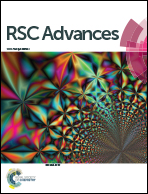Reduction of hexavalent chromium using epigallocatechin gallate in aqueous solutions: kinetics and mechanism
Abstract
The reduction of hexavalent chromium (Cr(VI)) to trivalent chromium (Cr(III)) by epigallocatechin gallate (EGCG) as a reductant in aqueous phase was studied in a batch experiment. Effects of EGCG concentration, reaction time, pH and temperature were examined. Acidic conditions and high temperature enhanced the reduction efficiency greatly. 96% of initial 100 μM Cr(VI) was reduced within 3 hours in the presence of equimolar EGCG at pH 3 and 25 °C. Cr(VI) reduction kinetics was evaluated under various initial Cr(VI) concentrations with excess EGCG over the pH range of 3–7.56, and results indicated that the reaction was first-order with respect to both the concentration of Cr(VI) and EGCG. Accordingly, two concurrent redox pathways involving zero and one proton may contribute to the observed overall rate dependence on pH. EGCG quinone, which has two hydrogen atoms removed from the trihydroxyphenyl B ring of the EGCG molecule, was identified as one of the oxidation products of EGCG. Our results highlight the potential of using EGCG for Cr(VI) reduction with both efficiency and safety aspects.


 Please wait while we load your content...
Please wait while we load your content...